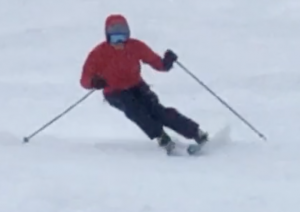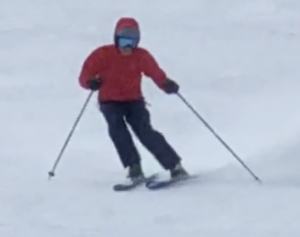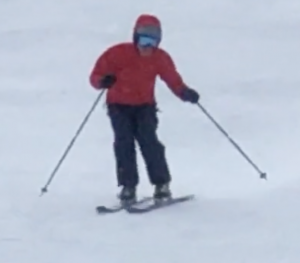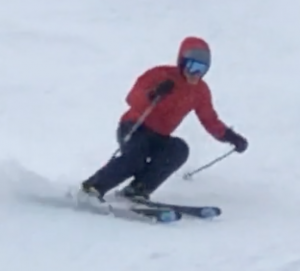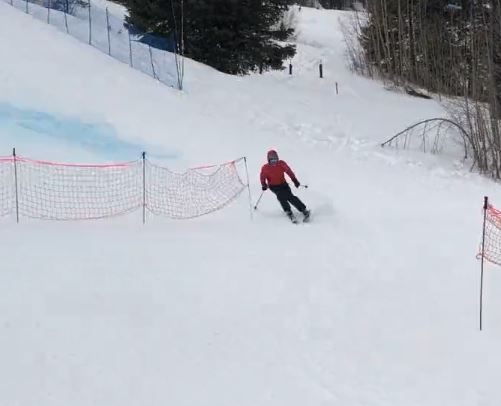First of
@asolo, you are going to need a coach. It's one thing to get advice from a ski forum, but another to have an external evaluator who can not only assign the work, but provide the critical feedback as to whether you are accomplishing the task or not. Your movement patterns are deeply ingrained and stem from not only your experience, but also from your belief system about how the skis perform, what movement patterns create performance, and your success in achieving those movement patterns. Don't get me wrong -- your current skiing is highly functional, but if you really want to find out what the skis can do for you, it is going to take more than an internet derived drill pattern and a bunch of repetitions.
So, where do you usually ski and are you able to form a long-term relationship with a coach?
Now onto what I (and I think others) see as the movements that need to be addressed to move you on the path of higher ski performance. Currently, you create edge by moving the upper body into the turn (inclining) and pushing the skis away from you until you achieve a high enough edge angle that the skis deflect and redirect your mass. As
@Doby Man indicated above, a more efficient movement patter is to create the edge by tipping the skis early in the turn. That is, you need to learn to stay with the ski but tip the lower body (specifically the lower legs) into the turn -- the upper body may follow, but the edging movements are driven by tipping the lower leg.
So, a place to start is to work on skating. Why skating? To efficiently skate, you need to be able to establish a platform that can accept pressure before propelling yourself off of that platform. Get on the souhortest, narrowest skis that you have -- narrow to minimize the leverage that comes from a wide ski, and short to make the whole exercise easier. To make this harder, find a level spot, or even one that is slightly uphill. This exercise should also be done without poles -- no cheating! To start skating, one leg is going to be the first one that you push off of. Have that ski at an oblique angle to your body -- say 45 degrees. Roll the knee in and down -- this tips the ski on edge -- and then push off and land and glide on the other foot. Roll that knee in and down and then push off of that foot. Don't push until you've rolled the knee in and down. Note that in order to accomplish the roll of the knee, you need to start in a relatively flexed position -- that is, somewhere around halfway between being tall and being as compressed as you could be. From this flexed position, the rolling of the knee down and in is actually being accomplished by rotating your femur (upper leg). Notice that when you get the knee moving in and down how much it tips the lower leg.o
Don't shortchange the skating practice. When I went through this progression, I spent more than 2 hours straight practicing it up and small hill. It's really useful to have a coach also watching to see that you are actually establishing the edge.
This whole first part of the progression is about learning how to tip the lower leg. It is NOT about pushing off of the edge once establish. In performance skiing, we almost never look to push the ski, so be sure you are focusing on the objective of this task -- it's about creating edge by tipping the lower leg RATHER THAN by pushing the ski away from you.
Once you have achieved the ability to tip the lower leg to establish edge, you can move onto the next step, which is how to apply the edge to carve a turn. This task uses J turns. A J turn is a simple CARVED turn starting from the skis being in the fall line. So, start in a straight run straight down the fall line on gentle terrain. BEFORE STARTING, LOOK FOR TRAFFIC ABOVE YOU! The skis should be running flat on their bases. Now use that down and in movement of the knee to create edge and continue to tip the skis. The objective is to have a perfectly carved turn that takes you not only across the hill, but also up the hill. See how far up the hill you can get. Look at your tracks to ensure that you are seeing a perfectly carved turn -- that is, you should have two pencil lines from the fall line all the way through the turn. REMEMBER THAT THE OBJECTIVE HERE IS TO TAKE THAT LOWER LEG TIPPING INTO THIS EXERCISE! So don't move the upper body into the turn -- tip the lower leg to engage the edge and turn the ski.
Given the video you provided here, I suspect you will have an issue with the inside foot/leg. if you are not being successful, first try picking up the tail of the inside ski in the fall line, then rolling the knee of the outside leg in and down to tip the ski. When you are able to achieve a carved turn on the one foot with the carve continuing a considerable distance up the hill, then we can turn our attention to the inside knee and ski.
Both knees need to move into the turn and down toward the snow. For the outside knee, the inside movement moves the knee toward the centerline of body, while the inside knee is moving externally, but still into the turn. So it's easiest to remember this as the knees move inside and down.
To focus further on the inside leg, think of driving the turn with that inside knee. So as you start the carve out of the fall line, focus on moving the inside knee into the turn and down toward the snow and allow the outside knee to follow. JF Beaulieu says that the inside leg is the decider and the outside leg is the rider. While almost all of your weight should be on the outside ski at this point, keep a small amount of pressure on the inside ski. Think about tracing the arc with that outside edge of the inside ski.
Once you can reliably generate arcs both directions in your J turns, try linking them together. Don't allow your movements to start with the upper body. As you roll into your first turn, roll those knees down and into the turn, then roll them from that turn to flat (feel flat for a second) then roll them down and into the next turn. Did you feel the skis carve cleanly from one turn to the next? If not, then think about whether you allowed the upper body to dive into the turn and take your edging away.
This will take a while to perfect. Make sure you start on easy terrain. Step up the steepness as you gain proficiency. Once you are able to carve even on a moderately steep slope, you will have started on the path to have a new movement pattern.
So, what is it that this progression is accomplishing and why is it important? What we are trying to do is to progressively establish edge high in the turn. And if the edge is established appropriately, without pivoting the ski, then the ski can and will bend. And if it bends early in the turn, then we are going to be able to move the point of maximum pressure up in the turn and you will correspondingly have more ability to send your mass across the hill. This will also give you access to speed control through turn shape rather than through displacing the ski.
Let's start there.
Mike
